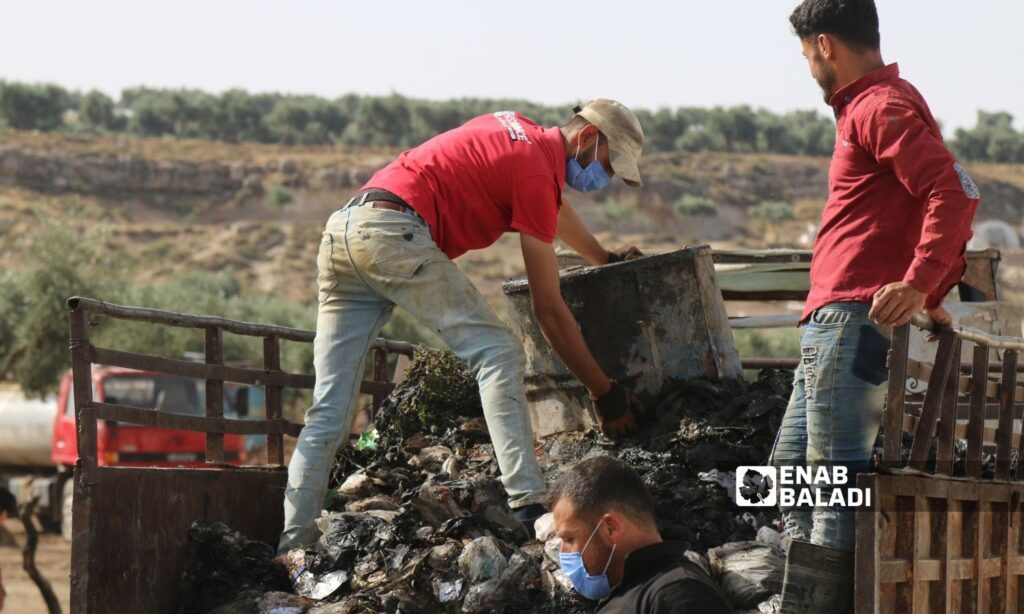Aleppo countryside – Dayan Junpaz
Diseases are spreading among residents of the Rajiein Orem camp in the town of Kafr Janna, northern Aleppo. The main cause is the lack of sewage networks and the accumulation of garbage and waste in the camp. Residents have become accustomed to using waste pits, which humanitarian organizations regularly clean and empty.
Since the beginning of June, the project to drain and empty the waste pits, provide drinking water, and remove garbage daily has stopped, doubling the spread of insects and diseases, according to camp residents interviewed by Enab Baladi.
Anas Khalil, a camp resident, complained about his scabies infection. He suffers from severe itching and a rash in sensitive areas such as the thighs, underarms, and abdomen, and all over his body.
He attributed the cause to the filth surfacing from the waste pits and the increased number of insects that infiltrate the tents.
He told Enab Baladi that he developed a rash (scabies) a few days ago and visited a doctor in Afrin city to get treatment. She prescribed him a medicine known as “Benzoate,” a liquid used after bathing, massaged into the whole body for up to three days.
Lice and leishmaniasis
Khalil fears for his children’s health after they got lice. They continue to live in areas conducive to the growth of germs and parasites, in addition to the risk of insect bites, mosquitoes, scorpions, and snakes near the camp.
Khalil frequently visits the pharmacy to buy medicines to treat his children. He mixes them with water and uses them to comb their hair to treat their lice and maintain their personal hygiene under the difficult health conditions they live in.
Khalil’s family’s situation reflects that of about 150 families living in the camp, including the family of Hassna Darwish, who told Enab Baladi that insects from the waste pits and garbage started spreading inside and outside the tents, causing her daughter to contract leishmaniasis.
The woman added that she has been incurring financial costs due to her daughter’s infection, needing regular hospital visits for necessary injections, with each injection costing 150 Turkish liras.
The World Health Organization (WHO) defines leishmaniasis as a skin disease usually transmitted through the bites of sandflies, which carry the disease from infected animals to humans. Rodents and gerbils are among the factors that help transmit it to humans.
Families interviewed by Enab Baladi in the camp appealed to humanitarian organizations and relevant authorities to intervene to solve the waste pits problem in the camp and demanded the necessity of having sewage networks or a mechanism to clean them.
Awaiting response
Salih Khalil, the director of Rajiein Orem camp, told Enab Baladi that the camp houses about 150 displaced families from several Syrian provinces. He noted that their support had stopped, as had support for several other camps in the neighboring area.
He explained that they are striving to find solutions but have not succeeded yet. They contacted the local council in Afrin city and the AFAD and Bahar organizations, but they had yet to receive any responses by the time this report was published.
The camp director pointed out the increasing spread of infectious diseases and epidemics in recent days, with expectations of more due to rising temperatures. He called for the return of support from the Bahar organization, which has overseen the project for four years.
On May 23, the Syria Response Coordination Group (SRCG), working in the area, recorded the spread of several skin diseases in the IDP camps in northwestern Syria, coinciding with rising temperatures and decreasing water supplies.
According to the team, only 34% of the camps have an established sewage system, while 66% suffer from exposed sewage, with one toilet for every 45 people in many of these camps.
Northwestern Syria is home to 5.1 million people, of whom 4.2 million need assistance, 3.4 million are food insecure, 3.4 million are internally displaced, and 2 million live in camps, according to the United Nations. Local statistics speak of 5.5 to 6 million people.
The cessation or reduction of international support threatens several sectors in northwestern Syria. In mid-May, the United Nations Office for the Coordination of Humanitarian Affairs (OCHA) announced that around 160 health facilities, including 46 hospitals, would have to suspend their operations by the end of June if funding is not increased.

